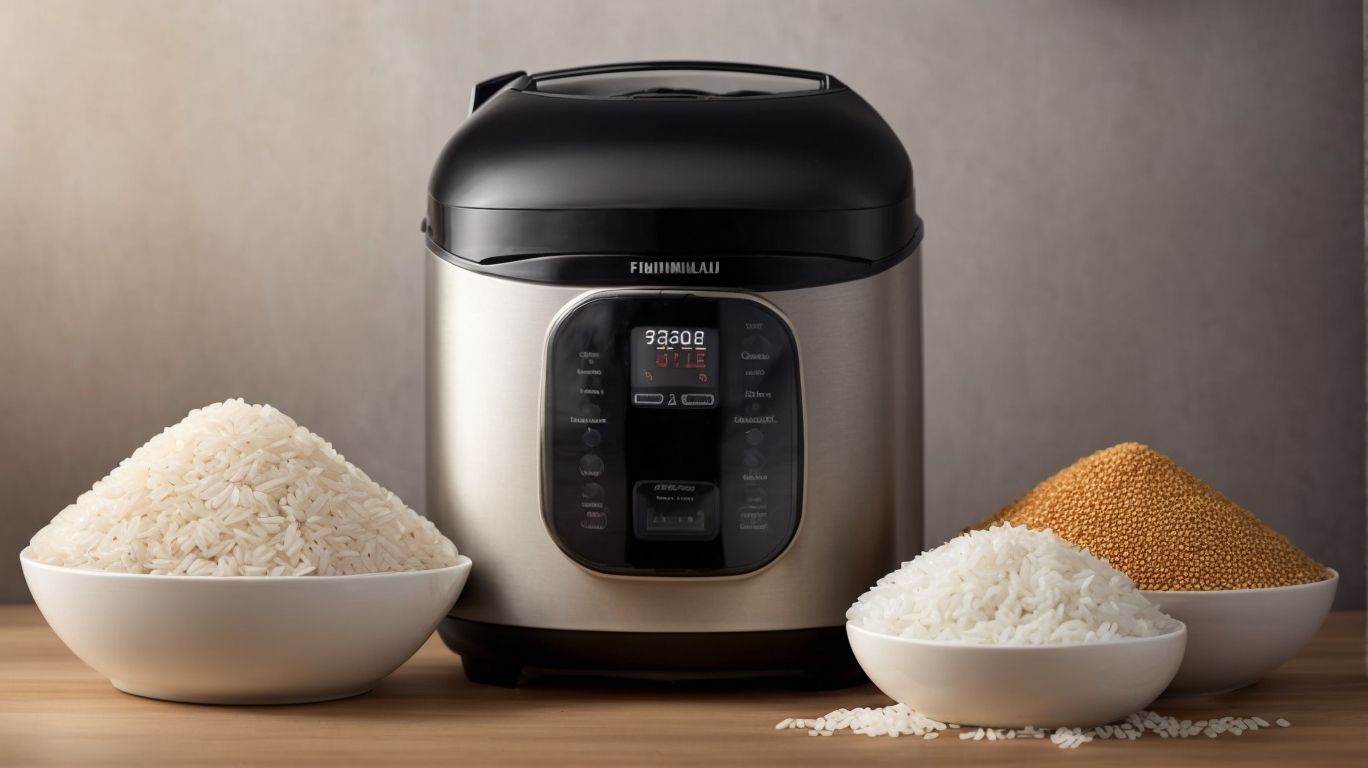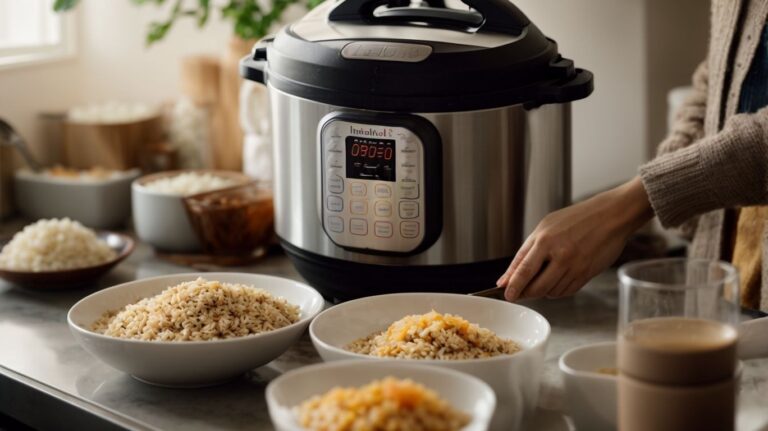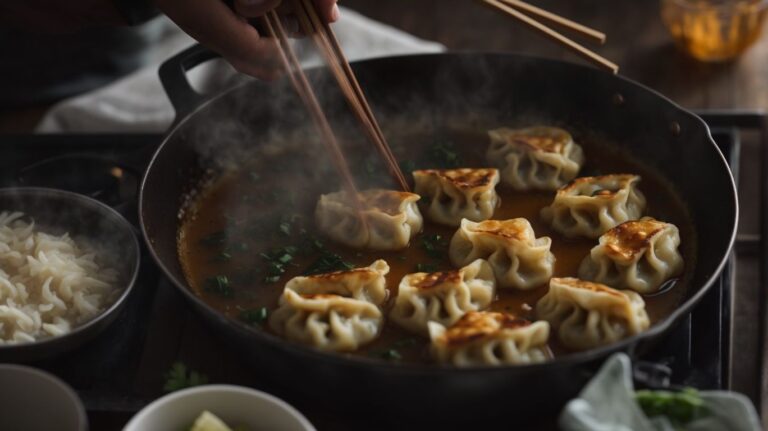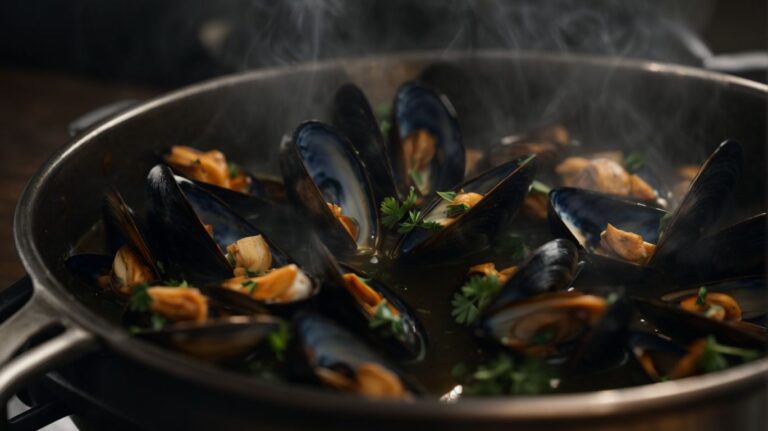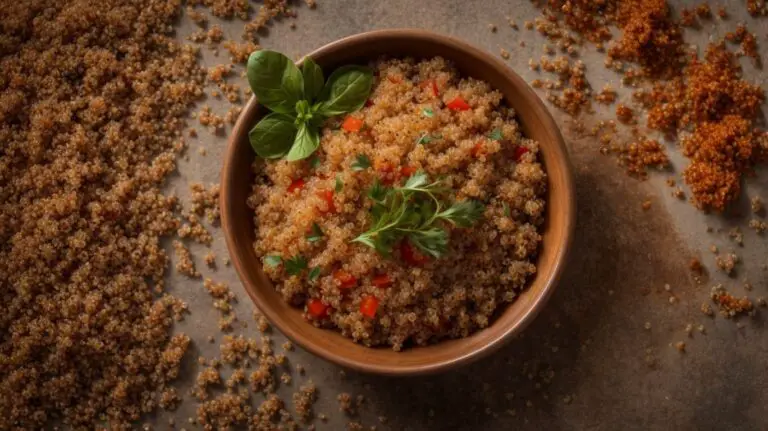How to Cook Rice in Rice Cooker Without Sticking?
Are you tired of rice sticking to the bottom of your pot or ending up overcooked and mushy? Look no further than a rice cooker to solve all your rice cooking woes.
We discuss the benefits of using a rice cooker, the types of rice you can cook in it, how to prepare rice for cooking, steps for cooking rice flawlessly, and tips to prevent sticking.
Stay tuned for valuable insights on cooking the perfect rice every time!
Key Takeaways:
Why Use a Rice Cooker for Cooking Rice?
Using a rice cooker for cooking rice offers numerous benefits that enhance the cooking experience.
One of the primary advantages of using a rice cooker is the consistent results it delivers every time. With precise temperature control and automated functions, rice cookers ensure that your rice is cooked to perfection, whether you prefer it fluffy or sticky.
Another significant perk is the time-saving aspect. Simply add the rice and water, press a button, and let the cooker handle the rest while you attend to other tasks. This convenience makes rice cookers invaluable for busy individuals or large households.
The ease of use of rice cookers is unmatched. With simple settings and minimal monitoring required, anyone can achieve delicious, well-cooked rice without the stress of stovetop methods.
Consistent Results
Rice cookers provide consistent results by utilizing steam to cook rice evenly and thoroughly.
Steam plays a crucial role in the rice cooking process as it circulates evenly within the cooker, ensuring that each grain is cooked to perfection. The steam helps to maintain the ideal moisture level, preventing the rice from becoming too dry or too mushy. This method of cooking not only guarantees fluffy and separate grains but also enhances the flavor and texture of the rice.
Rice cookers are equipped with advanced technology that regulates the steam pressure and temperature, creating the optimal environment for cooking rice. This precision in steam control is what sets rice cookers apart from traditional stovetop methods, where achieving consistent results can be more challenging.
Time-Saving
One of the key advantages of using a rice cooker is the time-saving aspect it offers in the cooking process.
By automating the entire rice cooking procedure, rice cookers take away the hassle of constantly checking on the pot to ensure the rice is not burnt or undercooked. This automation allows individuals to multitask or attend to other kitchen duties without worrying about the rice getting overcooked.
Eliminating the need for constant monitoring, rice cookers give users the freedom to set the cooking time and move on to other tasks until the perfectly cooked rice is ready. The precise timing and temperature control feature in modern rice cookers ensures uniform cooking without the risk of burning or unevenly cooked grains.
Easy to Use
Rice cookers are known for their user-friendly design and ease of operation, making them suitable for both novice and experienced cooks.
One of the key features that enhance the usability of rice cookers is their preset cooking functions, allowing users to simply add rice and water, press a button, and let the cooker do the rest. These appliances often come with clear digital displays and intuitive controls, making it effortless to select the desired cooking mode or set a timer.
What Type of Rice Can Be Cooked in a Rice Cooker?
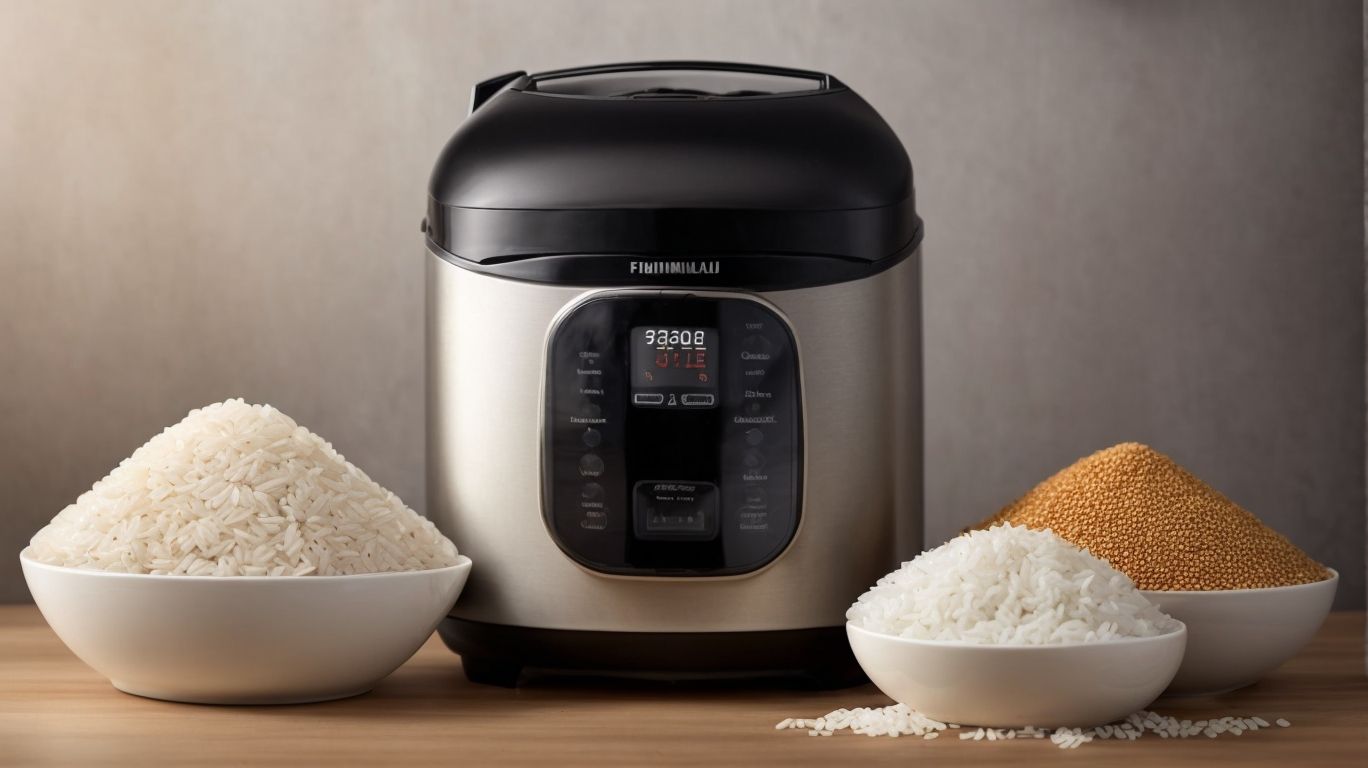
Credits: Poormet.Com – Timothy Perez
Rice cookers are versatile appliances capable of cooking various types of rice, including white rice, brown rice, and aromatic varieties like Basmati.
One popular type of rice that can be effortlessly cooked in a rice cooker is Jasmine rice. With its delicate aroma and slightly sticky texture when cooked, Jasmine rice is a staple in Asian cuisine.
Another interesting variety that is perfect for a rice cooker is wild rice. Combining nutty flavors and chewy texture, wild rice adds a unique element to dishes and is often used in salads or mixed rice blends.
Rice cookers also excel in preparing sushi rice, which requires a specific cooking technique to achieve the ideal stickiness and glossiness for sushi rolls.
White Rice
White rice is a common and popular choice for cooking in rice cookers, producing fluffy and separate grains with each batch.
When cooking white rice in a rice cooker, it is essential to follow the proper steps for achieving optimal results. Measure the desired amount of white rice and rinse it under cold water until the water runs clear to remove excess starch. This rinsing process helps to prevent the rice from becoming too sticky.
Next, add the rinsed rice to the rice cooker along with the appropriate amount of water, following the recommended rice to water ratio for fluffy grains. Close the lid of the rice cooker and select the ‘white rice’ setting for perfectly cooked rice.
Brown Rice
Brown rice, known for its nutty flavor and chewy texture, can be effectively cooked in a rice cooker to preserve its unique qualities.
Cooking brown rice in a rice cooker is a straightforward process that ensures a perfect outcome every time. To start, measure the desired amount of brown rice and rinse it thoroughly under cold water to remove excess starch. This step helps in enhancing the nutty flavor and chewy texture of the rice. Once rinsed, add the rice to the rice cooker along with the appropriate amount of water, typically using a 1:2 rice to water ratio. The rice cooker will then automatically adjust the cooking time and temperature to achieve optimal results.
It’s important to let the rice sit for a few minutes after cooking to allow for the final absorption of any remaining liquid, which helps in creating the ideal consistency. Avoid lifting the lid during the cooking process to ensure proper steam retention and consistent cooking. The gentle and even heat distribution in a rice cooker plays a crucial role in maintaining the integrity of brown rice, preserving its distinct nutty flavor and satisfying chewiness.
Jasmine Rice
Jasmine rice, prized for its fragrant aroma and delicate texture, can be easily prepared in a rice cooker to retain its aromatic qualities.
Cooking Jasmine rice in a rice cooker is a simple and efficient way to bring out the best flavors of this aromatic grain. To start, rinse the rice thoroughly in a bowl of cold water, swirling it around gently until the water turns cloudy. This helps remove excess starch, resulting in a fluffier texture once cooked. After rinsing, add the rice to the rice cooker along with the appropriate amount of water according to the rice cooker’s instructions. Allow the rice to steam until cooked, then let it rest for a few minutes to finish the cooking process.
How to Prepare Rice for Cooking in a Rice Cooker?
Properly preparing rice before cooking in a rice cooker is essential for achieving optimal results and enhancing the taste and texture of the rice dish.
Start by measuring the desired amount of rice using a measuring cup. Rinse the rice thoroughly under cold water in a fine-mesh strainer to remove excess starch, which can make the rice sticky. The rinsing process helps to improve the overall texture of the cooked rice. After rinsing, let the rice drain for a few minutes. For some varieties, soaking the rice in water for about 15-30 minutes before cooking can help it cook more evenly. Once the rice is rinsed and, if desired, soaked, add the appropriate amount of water based on the type of rice being used.
Rinse the Rice
Rinsing the rice thoroughly before cooking helps remove excess starch and impurities, resulting in fluffier and less sticky rice grains.
When rice is harvested, it undergoes a milling process that leaves a powdery residue on the grains. This residue is the starch content blending with impurities that can affect the flavor and texture of the cooked rice. By rinsing the rice, you can eliminate this excess starch and unwanted particles, ensuring a cleaner taste and a more distinct texture. Starch removal through rinsing also prevents the grains from clumping together, resulting in a deliciously fluffy and separate outcome. So, the next time you prepare rice dishes, don’t skip this crucial step of rinsing!
Measure the Rice and Water Ratio
Accurately measuring the ratio of rice to water is crucial for ensuring perfectly cooked rice in a rice cooker, preventing undercooking or overcooking.
In terms of different types of rice, such as white rice, brown rice, jasmine rice, and basmati rice, the ideal rice-to-water ratio varies. For example, for white rice, a common ratio is 1:2, which means 1 cup of rice to 2 cups of water. For brown rice, a ratio of 1:2.5 or even 1:3 is often recommended due to its longer cooking time and higher fiber content.
Experiment with the ratios to find the perfect balance for the type of rice you are cooking. Using a measuring cup specifically for rice and water can help maintain consistency in your cooking results. Remember, the rice-to-water ratio is just one element in achieving delicious, fluffy rice; factors like rinsing the rice before cooking and allowing it to rest after cooking also contribute to the final outcome.
Soak the Rice (Optional)
Soaking the rice before cooking, though optional, can help improve the texture and cooking consistency of certain rice varieties in a rice cooker.
When you soak rice before cooking, you allow the grains to absorb moisture, which can result in a more uniform texture throughout the dish. This process helps the rice cook more evenly, preventing any undercooked or overcooked grains.
Soaking also aids in shortening the actual cooking time required. By hydrating the grains beforehand, the rice cooker can efficiently steam the rice, cutting down on the overall cooking duration.
Certain types of rice, like basmati or jasmine rice, can particularly benefit from soaking as it enhances their natural aroma and fluffiness.
Steps for Cooking Rice in a Rice Cooker
Cooking rice in a rice cooker involves simple steps that ensure consistent and delicious results with minimal effort.
-
First, measure the desired amount of rice using a cup or scale, depending on your preference.
Rinse the rice in a separate container until the water runs clear to remove excess starch.
Next, add the rinsed rice to the rice cooker pot along with the corresponding amount of water according to the type of rice being cooked.
-
Close the lid securely and select the appropriate cooking setting based on the type of rice (e.g., white, brown, jasmine).
Let the rice cooker work its magic as it automatically adjusts the cooking time and temperature to ensure perfectly fluffy rice every time.
Add Rice and Water to the Rice Cooker
The first step in cooking rice in a rice cooker is to add the measured rice and water to the inner pot of the cooker, ensuring the proper ratio for optimal cooking.
It’s crucial to follow the recommended proportions to achieve perfectly cooked rice. Too much water can result in mushy rice, while too little may lead to undercooked grains. Finding the right balance is key. Some rice cookers come with handy measurement markings on the inner pot, making it easier to get the ratios right. Make sure to fluff the rice gently with a fork after adding the water to ensure even cooking and prevent clumping. This step sets the foundation for delicious, fluffy rice that complements any meal perfectly.
Turn on the Rice Cooker
After adding the rice and water, turn on the rice cooker and select the appropriate cooking mode or settings based on the type of rice being prepared.
Choosing the right cooking mode is crucial to ensure your rice turns out perfectly cooked every time. Different types of rice, such as white rice, brown rice, jasmine rice, or sushi rice, require specific cooking settings to achieve the ideal texture and flavor. For example, selecting the ‘White Rice’ mode for jasmine rice might result in overcooked grains. Refer to the rice cooker’s manual or recommended guidelines to match the ideal cooking mode with the variety of rice you are using.
Let the Rice Cook
Allow the rice to cook undisturbed in the rice cooker until the steam indicates that the rice is fully cooked and ready to be served.
During this final stage of rice cooking, the rice grains absorb the remaining moisture and expand to their full plumpness. The heat and steam circulating in the rice cooker ensure that each grain is cooked evenly, resulting in a perfectly fluffy texture. Patience is key at this phase, as opening the lid prematurely can disrupt the cooking process and lead to unevenly cooked rice. It’s essential to trust the rice cooker’s timing and resist the temptation to peek until the cooking cycle is complete.
Tips for Preventing Rice from Sticking to the Rice Cooker
Preventing rice from sticking to the rice cooker requires specific techniques and precautions to maintain the integrity of the rice grains and the non-stick surface of the cooker.
One effective tip is to adjust the water levels appropriately when cooking rice. Use the recommended water-to-rice ratio suggested by the rice cooker manual or follow general guidelines – too much water can make rice mushy, while too little can cause it to stick. Refrain from stirring the rice during the cooking process, as this can break the grains and lead to stickiness.
After the rice is cooked, allow it to rest for a few minutes before opening the lid. This resting period enables the excess moisture to distribute evenly, resulting in fluffy and separate grains. Make sure to clean your rice cooker thoroughly after each use to prevent any residue buildup that may contribute to sticking issues in the future.
Use the Right Amount of Water
Ensuring the correct water-to-rice ratio is crucial in preventing rice from sticking to the rice cooker and achieving fluffy, separate grains.
When cooking rice, measuring water accurately can make all the difference. To achieve that perfect texture, you need just the right amount of water in relation to the rice grains. Too much water and you risk ending up with a mushy consistency, while too little can leave your rice dry and unevenly cooked. By understanding the ideal water ratios and adjusting based on the type of rice you are using, you can say goodbye to the frustration of sticky residue and welcome perfectly cooked, fluffy rice every time.
Do Not Stir the Rice During Cooking
Avoid stirring the rice during the cooking process in the rice cooker to prevent disruption of the grains and maintain the desired texture.
When the rice begins to cook in the rice cooker, the steam and heat create a controlled environment that allows the grains to absorb the liquid evenly without agitation. This gentle cooking method ensures that each grain cooks uniformly, resulting in a fluffy and separate texture ideal for various dishes.
If you constantly stir the rice while it’s cooking, you risk breaking the grains and releasing excess starch, leading to a gummy consistency. By allowing the rice to steam undisturbed, you enhance the natural flavors and textures of the grains, producing a superior end result.
Let the Rice Rest Before Serving
Allow the cooked rice to rest for a few minutes after cooking in the rice cooker to stabilize the texture and flavors before serving.
Letting the rice rest helps in distributing the moisture evenly throughout the rice grains, resulting in a more uniform texture and enhancing the overall eating experience.
This resting period also allows the flavors to deepen and meld together, giving the dish a more harmonious and developed taste.
Resting the rice after cooking is a crucial step in maintaining its quality and ensuring that each bite is a delightful experience for the palate.
Conclusion
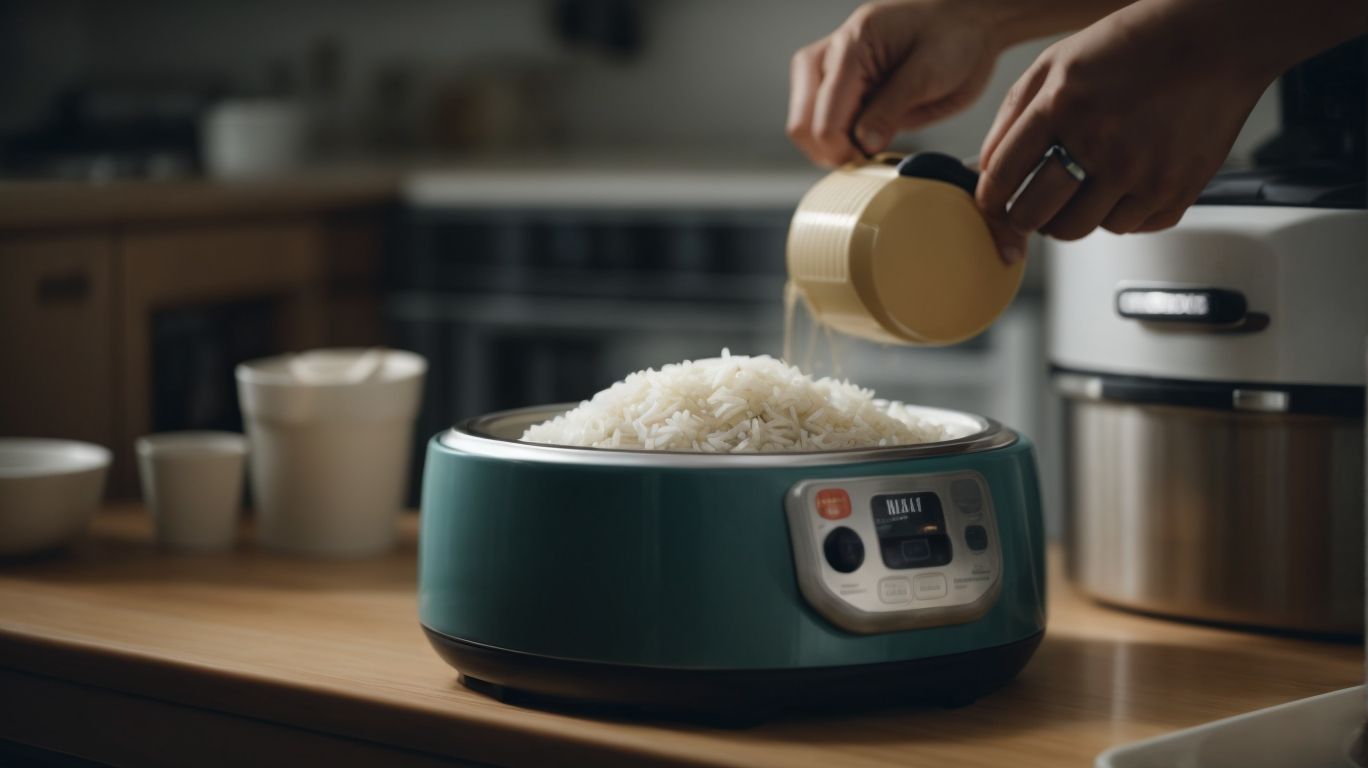
Credits: Poormet.Com – Vincent Anderson
Using a rice cooker offers a convenient and reliable way to prepare a variety of rice dishes with consistent results and minimal effort.
A rice cooker simplifies the whole process by automatically controlling the temperature and timing required for perfect rice every time. This eliminates the need for constant monitoring or worrying about overcooking or burning. These kitchen appliances often come with handy features like keep-warm and delay-start functions, ensuring your rice stays warm and ready to serve whenever you’re ready. The efficient design of modern rice cookers allows you to not only cook plain rice but also experiment with different grains, like quinoa or even steam vegetables simultaneously for a complete meal solution.
FAQs About Cooking Rice in a Rice Cooker
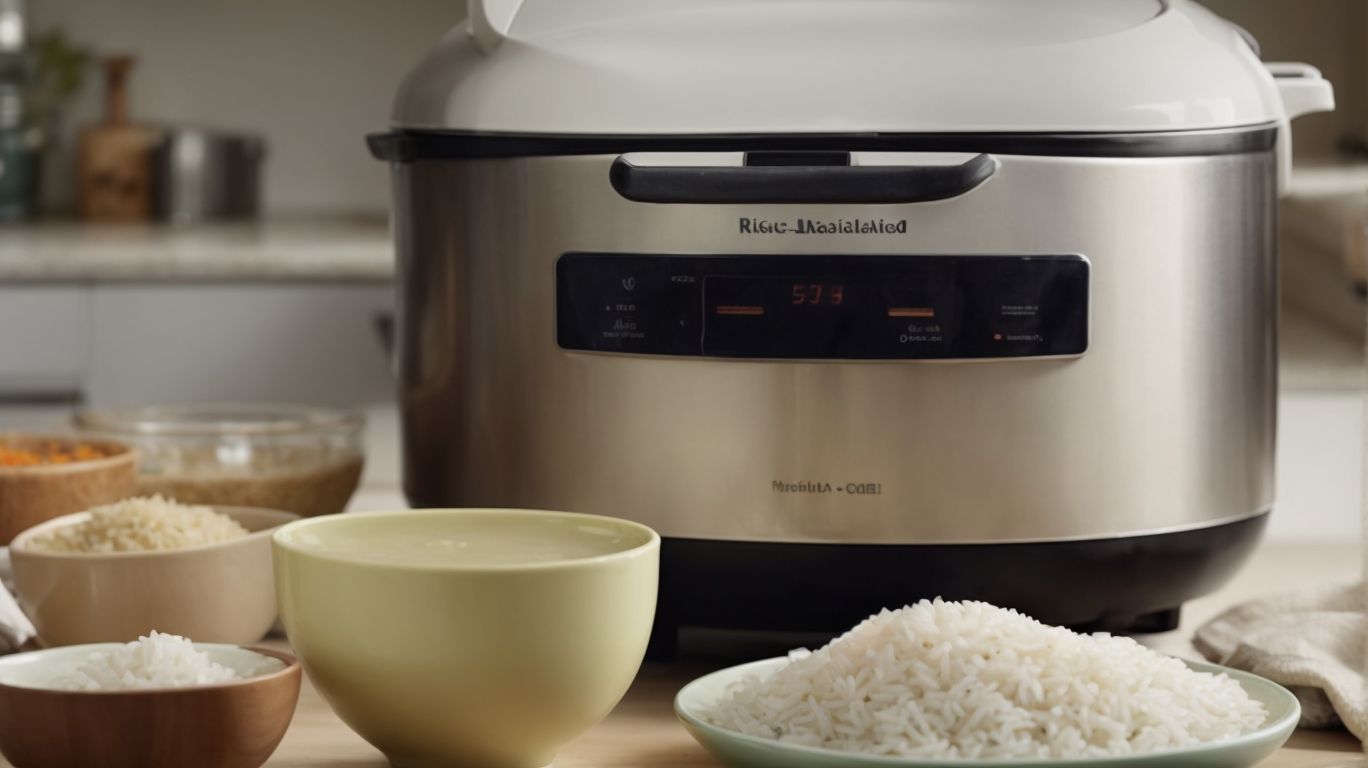
Credits: Poormet.Com – Nathan Clark
Exploring common questions and concerns about cooking rice in a rice cooker can provide valuable insights into optimizing the cooking experience and resolving potential issues.
Cooking rice is a fundamental skill in many kitchens, and using a rice cooker can simplify the process. However, choosing the right type of rice is crucial for achieving perfect results. Whether you prefer white rice, brown rice, jasmine, basmati, or wild rice, each variety may require slight adjustments in water ratio and cooking time. Understanding the nuances of different grains can elevate your culinary creations and introduce variety to your meals.
Can I Cook Other Grains in a Rice Cooker?
Rice cookers can be versatile appliances capable of cooking a variety of grains beyond rice, expanding the culinary possibilities and serving as multi-functional kitchen appliances.
One of the main advantages of rice cookers is their ability to cook a wide range of grains such as quinoa, barley, bulgur, and even steel-cut oats, providing a convenient way to prepare nutritious meals. Modern rice cookers come equipped with different cooking modes such as steaming, slow cooking, and even baking, allowing users to experiment with various cuisines and dishes beyond traditional rice recipes.
The versatility of rice cookers extends to cooking legumes like lentils and beans, making them essential appliances for those following plant-based diets. Some advanced models feature programmable settings for different types of grains, ensuring optimal cooking results every time.
How Do I Clean a Rice Cooker?
Proper cleaning and maintenance of a rice cooker are essential to ensure its longevity and optimal performance in cooking various rice and grain dishes.
In terms of cleaning your rice cooker, always start by unplugging the unit and allowing it to cool down completely. Remove any leftover rice or grain remnants using a soft cloth or sponge. Remember to never immerse the main unit in water; instead, use a damp cloth to wipe the exterior clean. For stubborn stains, a mixture of vinegar and water can be effective.
In terms of maintenance, regularly check the seals and ensure they are intact to prevent steam from escaping. It’s also important to descale the cooker periodically to prevent mineral build-up that could affect its functionality. Watch the power cord for any signs of damage and always follow the manufacturer’s guidelines for best practices.
If you encounter any issues, such as inconsistent cooking or burning smells, refer to the user manual for troubleshooting tips. Checking the heating element and ensuring it is clean can often solve many common problems. By following these cleaning and maintenance guidelines, you can enjoy delicious rice dishes for years to come.
Can I Cook Rice in a Slow Cooker?
While primarily designed for slow cooking meals, some slow cookers may offer rice cooking functions that allow users to prepare rice dishes with a different cooking approach.
Unlike traditional rice cookers that use direct heat to cook rice quickly, slow cookers employ a low and steady heat over a longer period, resulting in a more gradual and gentle cooking process. This method helps retain the flavors and nutrients of the rice, creating a richer and more aromatic dish. Slow cookers also provide the convenience of set-and-forget cooking, allowing users to prepare rice dishes without constant monitoring. The versatility of slow cookers allows for experimenting with different types of rice, grains, and flavorings to achieve a variety of delicious results.
Frequently Asked Questions
How to cook rice in rice cooker without sticking?
Cooking rice in a rice cooker can be tricky, especially if you want to avoid the rice from sticking to the bottom. Here are some FAQs to help you cook perfect rice in your rice cooker without any sticking.
What type of rice is best to use in a rice cooker?
Any type of white rice, such as jasmine, basmati, or long grain, works well in a rice cooker. Avoid using brown rice as it requires a longer cooking time and may result in sticking.
Do I need to rinse the rice before cooking in a rice cooker?
It is always a good idea to rinse the rice before cooking, regardless of the method. Rinsing removes any excess starch, which can cause the rice to stick together.
How much water should I add when cooking rice in a rice cooker?
The general rule of thumb for cooking rice in a rice cooker is to use 1 1/2 to 2 cups of water for each cup of rice. However, this may vary depending on the type of rice and the desired consistency.
Why is my rice still sticking to the bottom of the rice cooker?
If your rice is still sticking after following the appropriate water-to-rice ratio, try adding a little bit of oil or butter to the water before cooking. This can create a barrier between the rice and the bottom of the cooker, preventing sticking.
Can I open the rice cooker during cooking to prevent sticking?
It is recommended not to open the rice cooker during cooking as this can disrupt the cooking process and result in unevenly cooked rice. If you are worried about sticking, try using the oil or butter method mentioned above.
How can I prevent the rice cooker from getting messy and sticky?
Cleaning your rice cooker regularly can help prevent mess and sticking. After each use, make sure to remove any leftover rice and rinse the pot with warm water. For tougher stuck-on rice, soak the pot in warm, soapy water before scrubbing with a non-abrasive sponge.

